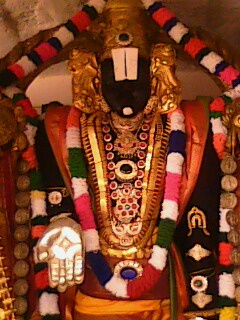
கௌசல்யா சுப்ரஜா ராம
பூர்வா ஸந்த்யா ப்ரவர்த்ததே
உத்திஷ்ட நர ஸார்தூல
கர்த்தவ்யம் தைவமாஹ்நிகம்
உத்திஷ்டோத்திஷ்ட கோவிந்த
உத்திஷ்ட கருடத்வஜ
உத்திஷ்ட கமலா காந்தா
த்ரைலோக்யம் மங்களம் குரு
மாத சமஸ்த ஜகதாம் மது கைடபாரே
வக்ஷோ விஹாரிணி மனோகர திவ்ய மூர்த்தே
ஸ்ரீ ஸ்வாமினி, ச்ரிதஜன ப்ரிய தான சீலே
ஸ்ரீ வேங்கடேச தயிதே தவ சுப்ரபாதம்
தவ சுப்ரபாதம் அரவிந்த லோசனே
பவது பிரசன்ன முக சந்திர மண்டலே
விதி சங்கரேந்திர வனிதாபிர் அர்ச்சிதே
விருஷ சைலநாத தயிதே தயாநிதே
அத்ரிஆதி சப்தரிஷய சமுபாஸ்ய சந்த்யாம்
ஆகாச சிந்து கமலானி மனோகரானி
ஆதாய பாதயுகம் அர்ச்சயிதும் ப்ரபந்நா
சேஷாத்ரி சேகரவிபோ தவ சுப்ரபாதம்
பஞ்சானன ஆப்ஜபவ சண்முக வாசவாத்யா
த்ரைவிக்ரமாதி சரிதம் விபுதா ச்துவந்தி
பாஷாபதி படதி வாசர சுத்திமாராத்
சேஷாத்ரி சேகரவிபோ தவ சுப்ரபாதம்
ஈஷத் ப்ரபுல்ல சரசீருஹ நாரிகேள
பூகத்ருமாதி சு மநோகர பாலிகாநாம்
ஆவாதி மந்த மநிலஸ் சக திவ்யகந்தை
சேஷாத்ரி சேகர விபோ தவ சுப்ரபாதம்
உந்மீல்ய நேத்ர யுக முத்தம பஞ்ஜரஸ்தா
பாத்ரா வசிஷ்ட கதலீபல பாயசாநி
புக்த்வா சலீலமத கேளிசுகா: படந்தி
சேஷாத்ரி சேகரவிபோ தவ சுப்ரபாதம்
தந்த்ரீ ப்ரகர்ஷ மதுர ஸ்வநயா விபஞ்ச்யா
காயத்ய நந்த சரிதம் தவ நாரதோபி
பாஷாச மக்ர அசக்ருத் கரசார ரம்யம்
சேஷாத்ரி சேகர விபோ தவ சுப்ரபாதம்
ப்ருங்காவலீ ச மகரந்த ரஸா நுவித்த
ஜங்கார கீத நிநதைஸ் சக சேவநாய
நிர்யாத்யு பாந்த சரஸீ கமலோ தரேப்ய
சேஷாத்ரி சேகர விபோ தவ சுப்ரபாதம்
யோஷா கணேன வரதத்னி விமத்ய மானே
கோசால யேஷூ ததி மந்தன தீவ்ர கோஷா
ரோஷாத் கலிம் விததே ககுபஸ்ச கும்பா
சேஷாத்ரி சேகர விபோ தவ சுப்ரபாதம்
பத்மேச மித்ர சதபத்ர கதாலி வர்க்கா
ஹர்த்தும் ச்ரியம் குவலயஸ்ய நிஜாங்க லக்ஷ்ம்யா
பேரீ நிநாத மிவ பீப்ரதி தீவ்ர நாதம்
சேஷாத்ரி சேகர விபோ தவ சுப்ரபாதம்
ஸ்ரீ மந் அபீஷ்ட வரதாகில லோக பந்தோ
ஸ்ரீ ஸ்ரீநிவாச ஜகதேக தயைக சிந்தோ
ஸ்ரீ தேவதா க்ருஹ புஜாந்தர திவ்ய மூர்த்தே
ஸ்ரீ வேங்கடாசலபதே தவ சுப்ரபாதம்
ஸ்ரீ சுவாமி புஷ்கரிணி- காப்லவ நிர்மலாங்கா
ச்ரேயோர் திநோ, ஹர விரிஞ்சி சனந்தன ஆத்யா
த்வாரே வசந்தி வரவேத்ர ஹதோத்த மாங்கா:
ஸ்ரீ வேங்கடாசலபதே தவ சுப்ரபாதம்
ஸ்ரீ சேஷசைல கருடாசல வேங்கடாத்ரி
நாராயணாத்ரி வ்ருஷபாத்ரி வ்ருஷாத்ரி முக்யாம்
ஆக்யாம் த்வதீய வசதே ரநிசம் வதந்தி
ஸ்ரீ வேங்கடாசல பதே தவ சுப்ரபாதம்
சேவாபரா: சிவ சுரேஷ க்ருசானு தர்ம
ரக்ஷோம்பு நாத பவமான தனாதி நாதா
பத்தாஞ்ஜலி ப்ரவிலசந் நிஐ சீர்ஷ தேசா:
ஸ்ரீ வேங்கடாசல பதே தவ சுப்ரபாதம்
தாடீஷூதே விஹக ராஜ மிருகாதி ராஜ
நாகாதி ராஜ கஜ ராஜ ஹயாதி ராஜா
ஸ்வஸ்வ அதிகார மஹி மாதிகம் அர்தயந்தே
ஸ்ரீ வேங்கடாசல பதே தவ சுப்ரபாதம்
தாடீஷூதே விஹக ராஜ மிருகாதி ராஜ
நாகாதி ராஜ கஜ ராஜ ஹயாதி ராஜா
ஸ்வஸ்வ அதிகார மஹி மாதிகம் அர்தயந்தே
ஸ்ரீ வேங்கடாசல பதே தவ சுப்ரபாதம்
த்வத் பாத தூளி, பரித ஸ்புரித உத்தமாங்கா
சுவர்கா அபவர்க நிரபேக்ஷ, நிஜாந்த ரங்கா!
கல்ப ஆகம ஆகலநயா ஆகுலதாம் லபந்தே
ஸ்ரீ வேங்கடாசல பதே தவ சுப்ரபாதம்
த்வத் கோபுர ஆக்ர சிகராணி, நிரீக்ஷ மாணா
ஸ்வர்கா அபவர்க பதவீம், பரமாம் ச்ரயந்த!
மர்த்யா மநுஷ்ய புவனே, மதி மாச்ரயந்தே
ஸ்ரீ வேங்கடாசல பதே தவ சுப்ரபாதம்!
ஸ்ரீ பூமி நாயக தயாதி குண அம்ருத ஆப்தே
தேவாதி தேவ ஜகத் ஏக சரண்ய மூர்த்தே
ஸ்ரீமந் அனந்த கருடாதிபிர் அர்ச்சி தாங்க்ரே
ஸ்ரீ வேங்கடாசல பதே தவ சுப்ரபாதம்
ஸ்ரீ பூமி நாயக தயாதி குண அம்ருத ஆப்தே
தேவாதி தேவ ஜகத் ஏக சரண்ய மூர்த்தே
ஸ்ரீமந் அனந்த கருடாதிபிர் அர்ச்சி தாங்க்ரே
ஸ்ரீ வேங்கடாசல பதே தவ சுப்ரபாதம்
ஸ்ரீ பத்மநாப புரு÷ஷாத்தம வாசுதேவ
வைகுண்ட மாதவ ஜனார்த்தன சக்ர பாணே
ஸ்ரீ வத்ஸ சிஹ்ன சரணாகத பாரிஜாத
ஸ்ரீ வேங்கடாசல பதே தவ சுப்ரபாதம்
கந்தர்ப்ப தர்ப்ப ஹர சுந்தர திவ்ய மூர்த்தே
காந்தா குசாம் புருஹ குட்மல லோல த்ருஷ்டே
கல்யாண நிர்மல குணாகர திவ்ய கீர்த்தே
ஸ்ரீ வேங்கடாசல பதே தவ சுப்ரபாதம்
மீனாக்ருதே- கமட- கோல- ந்ருசிம்ம- வர்ணிந்ஸ்வாமிந்- பரஸ்வத தபோதன- ராமசந்திர-
சேஷாம்ச ராம- யது நந்தன- கல்கி ரூப-
ஸ்ரீ வேங்கடாசல பதே தவ சுப்ரபாதம்
ஏலா லவங்க கனசார சுகந்தி தீர்த்தம்
திவ்யம் வியத்சரிதி ஹேம கடேஷூ பூர்ணம்
த்ருத் வாத்ய வைதிக சிகாமணய ப்ருஹ்ருஷ்டா
திஷ்டந்தி வேங்கட பதே தவ சுப்ரபாதம்
பாஸ்வான் உதேதி விகசாநி சரோருகானி
சம்பூர யந்தி நினதை ககுபோ விகங்கா
ஸ்ரீவைஷ்ணவா சததம் அர்த்தித மங்களாஸ்தே
தாமாச்ரயந்தி தவ வேங்கட சுப்ரபாதம்
பிரம்மா ஆதய சுரவரா ச மகர்ஷ யஸ்தே
சந்தஸ் சனந்தன முகாஸ் தவ யோகி வர்யா
தாமாந்திகே தவஹி மங்கள வஸ்து ஹஸ்தா
ஸ்ரீ வேங்கடாசல பதே தவ சுப்ரபாதம்
லஷ்மீ நிவாச நிரவத்ய குணைக சிந்தோ
சம்சார சாகர சமுத்தர அநைக சேதோ
வேதாந்த வேத்ய நிஜ வைபவ பக்த போக்ய
ஸ்ரீவேங்கடாசல பதே தவ சுப்ரபாதம்
இத்தம் விருஷாசல பதே, இக சுப்ரபாதம்
யே மானவா, ப்ரதி தினம் படிதும் ப்ர-விருத்தா
தேஷாம் பிரபாத சமயே, ஸ்மிருதி ரங்க பாஜாம்
பிரஜ்ஞாம், பர ஆர்த்த சுலபாம், பரமாம் ப்ரசுதே



























